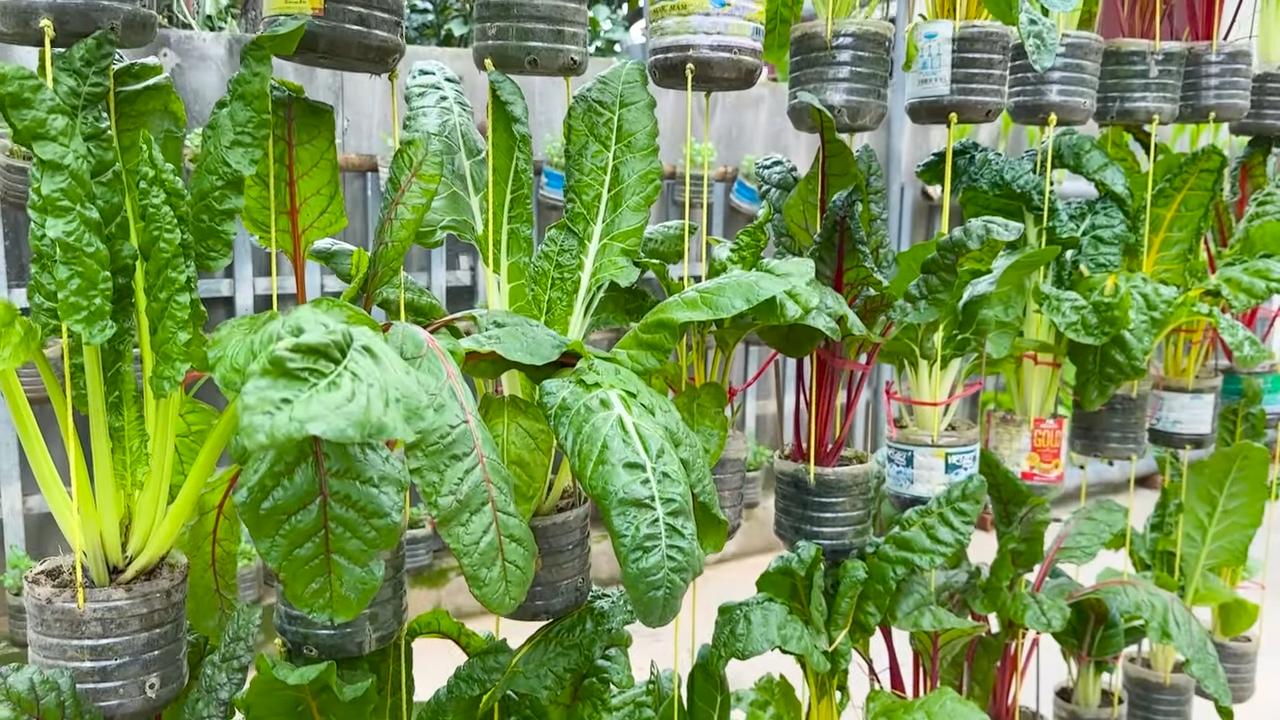Rooftop Swiss Chard Gardening: Imagine stepping onto your rooftop and harvesting vibrant, colorful Swiss chard leaves, ready to be tossed into a fresh salad or sautéed for a delicious side dish. Sounds dreamy, right? Well, it doesn’t have to be just a dream! For centuries, urban dwellers have sought creative ways to bring nature closer, and rooftop gardening, including growing your own Swiss chard, is a fantastic way to do just that.
I know what you might be thinking: “Rooftop gardening? Sounds complicated!” But trust me, it’s more accessible than you think. This DIY guide is designed to demystify the process and equip you with simple, effective tricks and hacks to cultivate a thriving rooftop Swiss chard gardening oasis, even if you’re a complete beginner.
Why Swiss chard, you ask? Beyond its stunning visual appeal, this leafy green is packed with nutrients and incredibly versatile in the kitchen. Plus, it’s relatively easy to grow, making it the perfect choice for rooftop gardens. In this article, I’ll share my favorite tips and tricks for choosing the right containers, preparing the soil, protecting your plants from the elements, and harvesting a bountiful crop. Get ready to transform your rooftop into a productive and beautiful edible garden!

Your Own Rooftop Garden: Growing Swiss Chard – Here’s How!
Hey garden friends! Do you also have an unused rooftop space that’s crying out for some life? Then let’s create a rooftop garden together and grow delicious Swiss chard! I’ll show you how to create a green oasis above the city rooftops with a few simple steps and a little love for detail. Don’t worry, it’s easier than you think!
What you need for your rooftop garden:
Before we get started, here is a list of everything you need for your Swiss chard rooftop garden adventure:
- Suitable planters: Choose lightweight but sturdy containers with good drainage. Remember that soil is heavy, so be mindful of the weight!
- High-quality potting soil: A mixture of garden soil, compost, and coconut coir is ideal.
- Swiss chard seeds or seedlings: Decide on your favorite variety! There are so many great colors and shapes.
- Drainage material: Expanded clay, gravel, or broken pottery shards for the bottom of the planters.
- Watering can or garden hose: For regular watering.
- Organic fertilizer: For a bountiful harvest.
- Gardening gloves: To protect your hands.
- Shovel and small rake: for preparing the soil.
- Possibly a windbreak: If your roof is very windy.
- Sun protection: Especially important in the hot summer months.
- Patience and love: The most important thing of all!
Safety Check Before You Start:
Important: Before you start creating your rooftop garden, you must have the structural integrity of your roof checked! Ask a professional if your roof can bear the additional weight of the soil, planters, and water. Safety first! Additionally, you should check with your local municipality to see if there are any special regulations or permits for rooftop gardens.
Step-by-Step Guide: Growing Swiss Chard on the Roof
Now let’s get down to it! Here is a detailed guide on how to create your own Swiss chard rooftop garden:
1. Preparation is Everything:
- Cleaning the rooftop area: First, remove all dirt, leaves, and other debris from your roof. A clean surface is important for drainage and prevents pests from settling in.
- Checking the waterproofing: Make sure the roof’s waterproofing is intact to avoid water damage. You should definitely have any small cracks or holes repaired.
- Planning the layout: Think about where you want to place the planters. Consider sun exposure and wind. Swiss chard needs a lot of sun but should be protected from strong winds.
2. Preparing the Planters:
- Add drainage: Cover the bottom of the planters with a layer of drainage material (expanded clay, gravel, or broken pottery). This prevents waterlogging and ensures good root aeration.
- Fill with soil: Fill the planters with high-quality potting soil. Leave about 5 cm (2 inches) of space at the top so you don’t overflow everything when watering.
- Loosen the soil: Loosen the soil with a small rake to prepare it for sowing or planting.
3. Sowing or Planting Swiss Chard:
- Sowing: If you want to grow Swiss chard from seeds, sow the seeds about 1-2 cm (0.4-0.8 inches) deep in the soil. Maintain a distance of about 10-15 cm (4-6 inches) between the seeds. Water the soil gently.
- Planting seedlings: If you are using seedlings, dig small holes in the soil large enough to accommodate the root balls. Place the plants in the holes and press the soil down lightly. Water the plants well.
4. Watering and Care:
- Regular watering: Swiss chard needs regular watering, especially during the hot summer months. Make sure the soil is always slightly moist, but not wet. Avoid waterlogging!
- Fertilizing: Fertilize your Swiss chard regularly with organic fertilizer. This ensures a rich harvest and healthy plants.
- Weeding: Remove weeds regularly so your Swiss chard has enough space and nutrients.
- Pest protection: Regularly check your plants for pests like aphids or slugs. If necessary, you can use organic pesticides.
5. Harvest Time:
- Regular harvesting: You can harvest the outer leaves of the Swiss chard as soon as they are large enough. The inner leaves will then continue to grow, and you can harvest repeatedly.
- Gentle harvesting: Cut the leaves with a sharp knife or scissors to avoid damaging the plant.
Additional Tips for Your Successful Rooftop Garden:
- Windbreak: If your roof is very windy, you should install a windbreak. This could be a hedge, a fence, or a tarp.
- Sun protection: In the hot summer months, the sun can be very intense. Protect your plants with a sun sail or a shade net.
- Irrigation system: If you don’t want to water every day, you can install an automatic irrigation system.
- Combination with other plants: Swiss chard combines well with other vegetables like radishes, lettuce, or carrots.
- Observation: Observe your plants regularly and adjust their care according to their needs.
Common Problems and Solutions:
- Yellow leaves: Can indicate a nutrient deficiency or waterlogging. Fertilize the plants and ensure good drainage.
- Aphids: Combat them with an organic pesticide or rinse them off with a strong jet of water.
- Slugs: Set up slug traps or pick the slugs off.
- Fungal diseases: Ensure good ventilation and avoid waterlogging. If necessary, you can use a fungicide.
Recipes with Swiss Chard:
Now that you have harvested your own Swiss chard, you can use it in many delicious dishes. Here are a few ideas:
- Sautéed Swiss Chard: Simply sauté with garlic and olive oil.
- Swiss Chard Soup: A healthy and warming soup.
- Swiss Chard Quiche: A savory quiche with Swiss chard and cheese.
- Swiss Chard Smoothie: For a green and vitamin-rich smoothie.
- Stuffed Swiss Chard Leaves: A tasty and vegetarian alternative to stuffed grape leaves.
Conclusion:
With a little planning and effort, you can create your own Swiss chard rooftop garden and harvest fresh, healthy vegetables right above the city rooftops. It’s a great feeling to watch the plants grow and thrive, and the harvest is the culmination of all your efforts. So, what are you waiting for? Get started and transform your roof into a green oasis! Happy gardening!

Conclusion
So, there you have it! Transforming your rooftop into a thriving Swiss chard garden is not only achievable but also incredibly rewarding. We’ve walked you through the essentials, from choosing the right containers and soil to understanding the specific needs of Swiss chard. But why is this DIY rooftop gardening trick a must-try?
Firstly, it’s about fresh, readily available produce. Imagine stepping onto your rooftop and harvesting vibrant, nutrient-packed Swiss chard for your dinner. No more last-minute grocery store runs or settling for wilted greens. The convenience and freshness are unparalleled.
Secondly, it’s an environmentally conscious choice. By growing your own food, you’re reducing your carbon footprint associated with transportation and packaging. You’re also contributing to a greener urban environment, providing a habitat for beneficial insects and improving air quality.
Thirdly, it’s a fantastic way to connect with nature, even in the heart of the city. The act of nurturing plants, watching them grow, and harvesting your own food is incredibly therapeutic and grounding. It’s a welcome escape from the hustle and bustle of urban life.
But the benefits don’t stop there. Rooftop gardening can also improve your home’s insulation, reducing energy costs. It can increase the value of your property and provide a unique and aesthetically pleasing outdoor space.
Variations and Suggestions:
Don’t be afraid to experiment! Try different varieties of Swiss chard, such as Bright Lights, Ruby Red, or Fordhook Giant. You can also companion plant your Swiss chard with other vegetables and herbs, such as lettuce, radishes, and basil. This can help to deter pests and improve the overall health of your garden.
Consider adding a small composting system to your rooftop to recycle kitchen scraps and create nutrient-rich soil for your Swiss chard. This is a great way to further reduce your environmental impact and improve the quality of your produce.
If you live in a particularly windy area, consider adding windbreaks to protect your Swiss chard from damage. This could be as simple as planting taller plants around the perimeter of your garden or installing a temporary fence.
And remember, rooftop gardening is a learning process. Don’t be discouraged if you encounter challenges along the way. Every mistake is an opportunity to learn and improve.
We encourage you to embrace this DIY rooftop gardening trick and experience the joy of growing your own Swiss chard. It’s a simple, sustainable, and incredibly rewarding way to enhance your life and connect with nature.
Now, we want to hear from you! Have you tried rooftop gardening before? What are your tips and tricks? Share your experiences and photos in the comments below. Let’s create a community of rooftop gardeners and inspire others to embrace this wonderful practice. Let us know how your **rooftop Swiss chard gardening** is going!
Frequently Asked Questions (FAQ)
What kind of containers are best for rooftop Swiss chard gardening?
The best containers for rooftop Swiss chard gardening are those that are durable, lightweight, and have adequate drainage. Consider using plastic pots, fabric grow bags, or even repurposed containers like old buckets or tubs. Ensure the containers are large enough to accommodate the root system of the Swiss chard, ideally at least 12 inches deep and wide. Lightweight materials are crucial to minimize the weight load on your roof. Also, dark-colored containers can absorb more heat, which can be beneficial in cooler climates but detrimental in hotter ones.
How often should I water my rooftop Swiss chard garden?
Watering frequency depends on several factors, including the weather, the type of container you’re using, and the soil’s drainage. Generally, you should water your Swiss chard when the top inch of soil feels dry to the touch. During hot, sunny weather, you may need to water daily, while in cooler, cloudier weather, you may only need to water every few days. Be sure to water deeply, allowing the water to drain out of the bottom of the container. Avoid overwatering, as this can lead to root rot. Using a moisture meter can help you determine the moisture level of the soil accurately.
What type of soil is best for growing Swiss chard on a rooftop?
Swiss chard thrives in well-draining, nutrient-rich soil. A good potting mix specifically formulated for vegetables is ideal. You can also create your own mix by combining equal parts of compost, peat moss (or coconut coir), and perlite or vermiculite. Compost provides essential nutrients, peat moss or coconut coir helps retain moisture, and perlite or vermiculite improves drainage. Avoid using garden soil, as it can be too heavy and compact for container gardening. Amending the soil with slow-release fertilizer at planting time can also provide a boost of nutrients.
How much sunlight does Swiss chard need to grow on a rooftop?
Swiss chard needs at least 6 hours of sunlight per day to thrive. Choose a location on your rooftop that receives full sun for most of the day. If your rooftop is partially shaded, try to position your containers in the sunniest spot. If you live in a particularly hot climate, providing some afternoon shade can help prevent the leaves from scorching. You can use shade cloth or strategically place taller plants to provide shade during the hottest part of the day.
What are some common pests and diseases that affect Swiss chard, and how can I prevent them?
Common pests that affect Swiss chard include aphids, slugs, snails, and leaf miners. Diseases include powdery mildew and fungal leaf spots. To prevent pests, inspect your plants regularly and remove any pests you find by hand. You can also use insecticidal soap or neem oil to control infestations. To prevent diseases, ensure good air circulation around your plants and avoid overwatering. Remove any infected leaves promptly. Companion planting with herbs like basil or marigolds can also help deter pests.
Can I grow Swiss chard on my rooftop in the winter?
Whether you can grow Swiss chard on your rooftop in the winter depends on your climate. Swiss chard is a relatively cold-hardy vegetable and can tolerate light frosts. In mild climates, you may be able to grow Swiss chard throughout the winter. In colder climates, you may need to provide some protection, such as covering your plants with a cold frame or greenhouse. You can also move your containers indoors to a sunny location.
How do I harvest Swiss chard from my rooftop garden?
You can begin harvesting Swiss chard leaves when they are about 6 inches long. Harvest the outer leaves first, leaving the inner leaves to continue growing. Cut the leaves at the base of the stem, near the soil level. Regular harvesting encourages the plant to produce more leaves. You can harvest Swiss chard throughout the growing season.
How can I use the Swiss chard I harvest from my rooftop garden?
Swiss chard is a versatile vegetable that can be used in a variety of dishes. You can sauté it, steam it, add it to soups and stews, or use it in salads. The stems are also edible and can be cooked like asparagus. Swiss chard is a good source of vitamins A, C, and K, as well as fiber and antioxidants.
Is rooftop Swiss chard gardening safe for my roof?
Rooftop gardening is generally safe, but it’s crucial to assess your roof’s weight-bearing capacity before starting. Consult with a structural engineer or building professional to determine the maximum weight your roof can safely support. Distribute the weight of your containers evenly across the roof. Use lightweight containers and soil mixes. Consider installing a waterproof membrane to protect your roof from water damage. Regular inspections of your roof are essential to identify and address any potential problems early on.
What are the benefits of rooftop Swiss chard gardening compared to traditional gardening?
Rooftop Swiss chard gardening offers several advantages over traditional gardening, especially in urban environments. It allows you to grow your own food even if you don’t have a yard. It can improve air quality and reduce the urban heat island effect. It can also provide a relaxing and therapeutic outdoor space. Rooftop gardens can be more accessible and easier to manage than traditional gardens, especially for people with mobility issues. Plus, it’s a great way to utilize otherwise unused space.




Leave a Comment